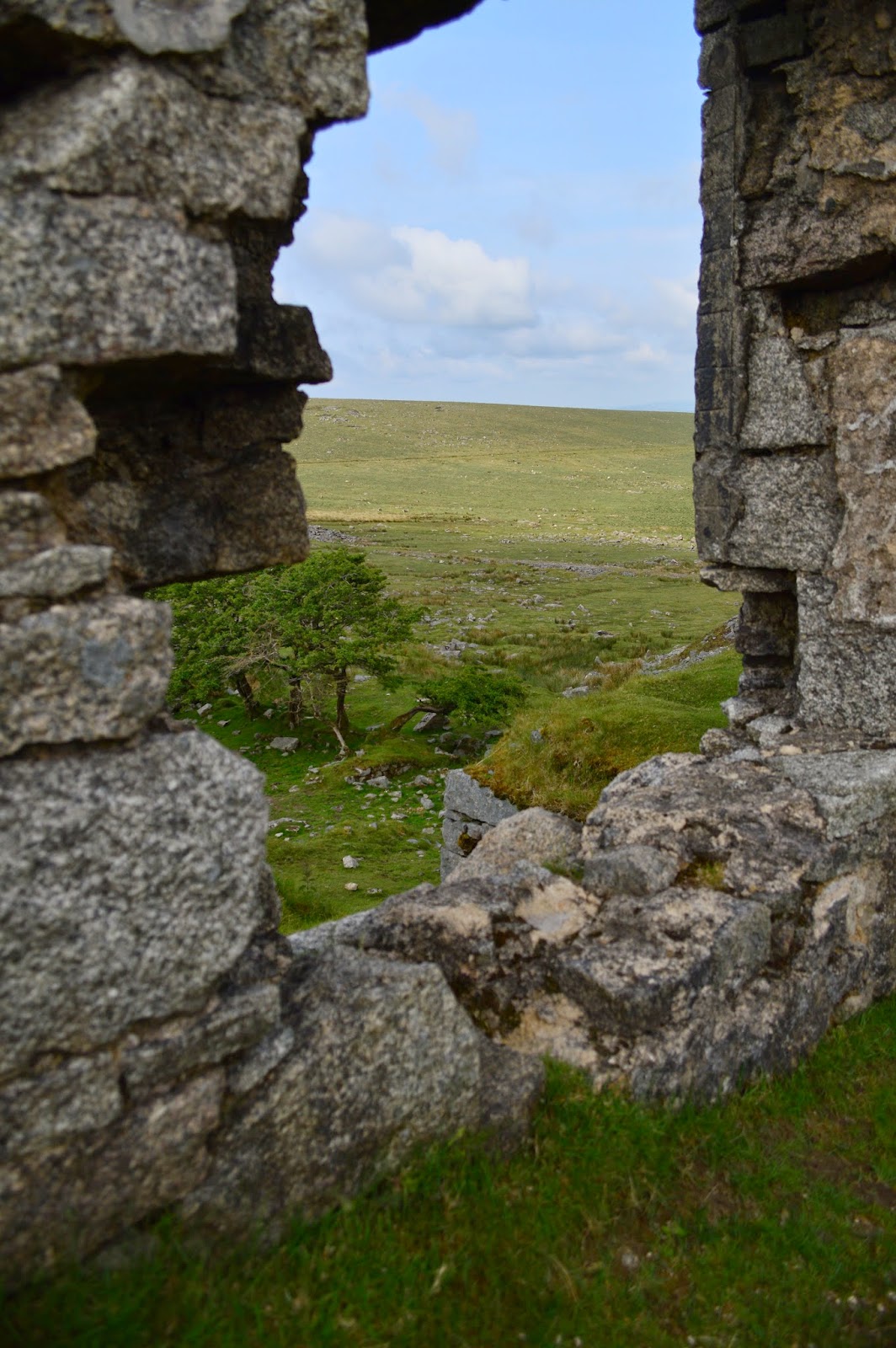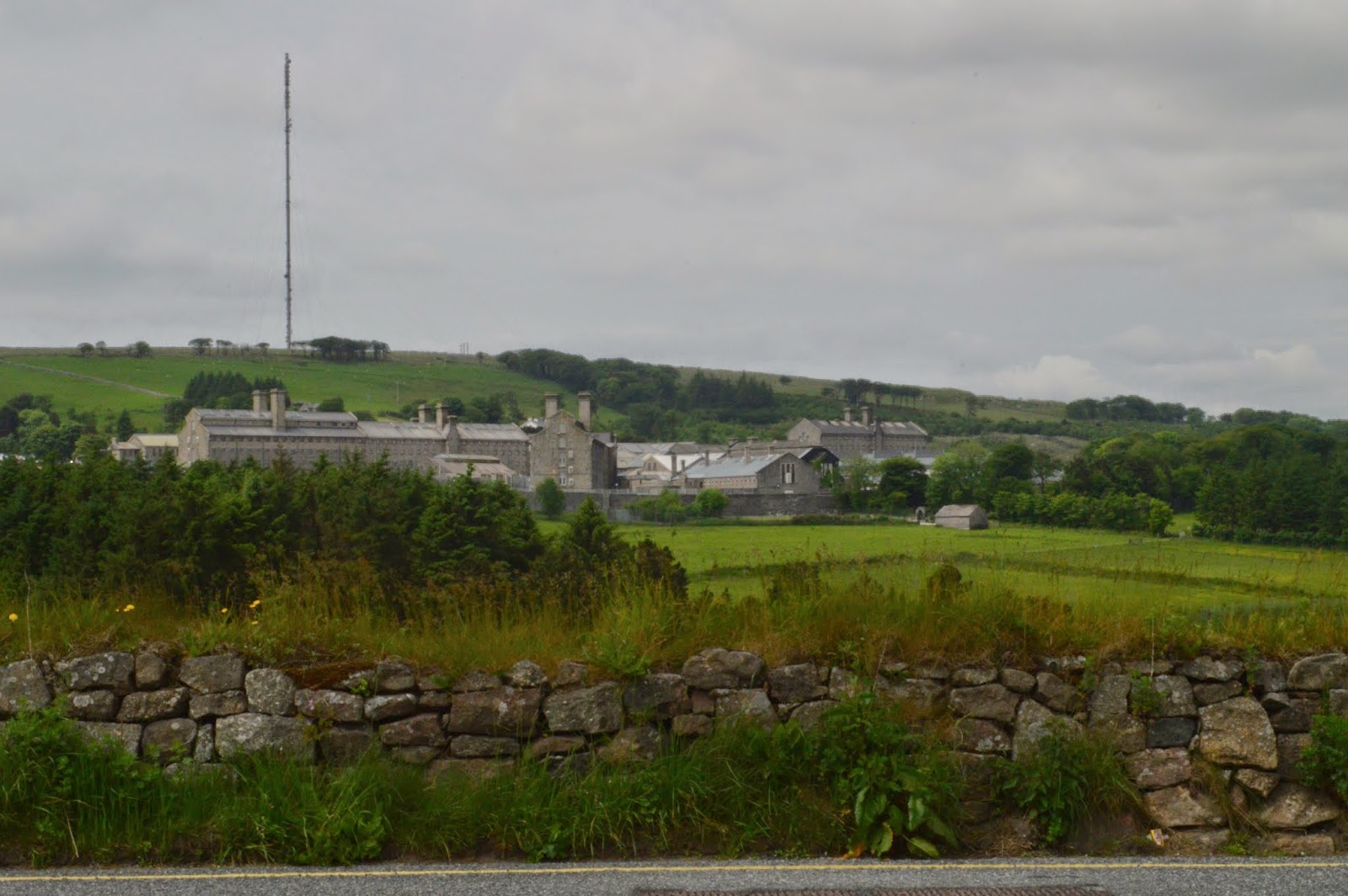Foggintor is a nice easy walk which along the way offers
some spectacular views . You don’t realize
this as you leave the car park in Princetown, Devon where there
are several cafes and stores to browse around.

 The path that leads you from the village winds past a farm
where curious ponies stare perhaps in the hope of scratch on the forehead from a friendly stranger. A slow gentle grade
takes you out into the wide open spaces of Dartmoor itself. The track is actually the bed of a tramroad
built in 1823 by Thomas Tyrwill which sadly closed in1956. This particular stretch once carried stone
from the nearby quarry to Plymouth and beyond.
Once a busy and bustling area one could image the quarrymen and their families
going about their day to day lives, but now it is a place of quiet solitude
with only the breezes and wild ponies for your companions. The views from the tram road are stunning,
opening the valley up beneath where you can see for miles in every direction
the road itself disappearing into the horizon.
The path that leads you from the village winds past a farm
where curious ponies stare perhaps in the hope of scratch on the forehead from a friendly stranger. A slow gentle grade
takes you out into the wide open spaces of Dartmoor itself. The track is actually the bed of a tramroad
built in 1823 by Thomas Tyrwill which sadly closed in1956. This particular stretch once carried stone
from the nearby quarry to Plymouth and beyond.
Once a busy and bustling area one could image the quarrymen and their families
going about their day to day lives, but now it is a place of quiet solitude
with only the breezes and wild ponies for your companions. The views from the tram road are stunning,
opening the valley up beneath where you can see for miles in every direction
the road itself disappearing into the horizon.
But I was not going that way. I was following the path around to the right
and working my way to Foggintor Quarry a short distance away.
Rounding a bend you can see the ruins of the quarry master’s house in the distance, a once very imposing and grand home, with only one wall remaining upright. As you approach you see the remains of other buildings which I later read had been a school, office and chapel.
 Amongst the remains is a grove of beautiful trees whose
branches have been misshapen over the years by the winds. They have grown up amongst the cut stones of
the house now scattered like children’s marbles. Wildflowers and tall grass cover the area
adding colour to the grey background of the stone walls and occasionally a sheep wanders in and
watches as you explore.
Amongst the remains is a grove of beautiful trees whose
branches have been misshapen over the years by the winds. They have grown up amongst the cut stones of
the house now scattered like children’s marbles. Wildflowers and tall grass cover the area
adding colour to the grey background of the stone walls and occasionally a sheep wanders in and
watches as you explore. 
The remains are well worth an "up close" investigation. The perspectives of the landscape changes as you stand within the doorstep and look out onto the moor.
It is a breathtaking view with a white farmhouse in the distance and the rolling hills that fade into the distance.

 Sitting on the sill of one of the
windows you can look down into the area where the other buildings once stood
and get a feel for how big these structures once were.
Sitting on the sill of one of the
windows you can look down into the area where the other buildings once stood
and get a feel for how big these structures once were.I spent a long time wandering around the ruins and walking away from them to turn and look back. In it’s day this must have been a formidable sight for workers and visitors. The structure was at least two stories in height from the front but when you look at it from the back you can clearly see that a doorway was once located under the house.
Fitting for the home of a man who ran the quarry and the lives of those who once worked for him.
The moor is slowly claiming back the rocks that once made up this building making it hard in places to distinguish between the real landscape and the man made.
Leaving the house behind I headed for the quarry itself, which once was Foggintor, now a water filled canyon. There are two paths, one leads into the quarry and the other rises steeply toward to the top which is the one I took. Standing on the edge looked down into its basin.
 The water below in a lovely
green from the minerals and you can see unfinished cuts of rocks under the
surface.
The water below in a lovely
green from the minerals and you can see unfinished cuts of rocks under the
surface.
From this vantage point you get a real sense as to how vast this quarry is, a quarry whose stone forms most of Nelson’s column in London and many buildings in Devon. From here too, you can have an incredible view beyond the quarry which I believe is toward the west (on this year’s travels I intend to carry a small compass and will endeavor to make a note of directions when I can). Hard to believe such a massive hole in the ground could exist in this place, perhaps a blight on the landscape from the hands of man and yet if they hadn’t quarried here, we would not have this unique view of the moor.
Leaving the house behind I headed for the quarry itself, which once was Foggintor, now a water filled canyon. There are two paths, one leads into the quarry and the other rises steeply toward to the top which is the one I took. Standing on the edge looked down into its basin.
 The water below in a lovely
green from the minerals and you can see unfinished cuts of rocks under the
surface.
The water below in a lovely
green from the minerals and you can see unfinished cuts of rocks under the
surface.From this vantage point you get a real sense as to how vast this quarry is, a quarry whose stone forms most of Nelson’s column in London and many buildings in Devon. From here too, you can have an incredible view beyond the quarry which I believe is toward the west (on this year’s travels I intend to carry a small compass and will endeavor to make a note of directions when I can). Hard to believe such a massive hole in the ground could exist in this place, perhaps a blight on the landscape from the hands of man and yet if they hadn’t quarried here, we would not have this unique view of the moor.
This area is used for many recreational activities. In fact there were several groups arriving to
take advantage of the water, ledges and nature.
A group of army cadets had spent the night on the moor, an outdoor
adventure group with climbing gear were preparing to abseil from the cliff tops
and some school children were out on a nature and history exploration day. As you can see even with all these people
around there is plenty of room to find space to be alone and enjoy the beauty
that surrounds you here.
One last look out into the quarry and moor beyond and I rejoined
the footpath that leads back to car park back along the tram road which still has granite sleepers from the time when horse
drawn wagons pulled heavy stone down to Plymouth. This was long before the age of steam trains,
an era which does not seem to factor in railway history and should, as it is
the precursor of the modern day rail system.
 The Princetown Railway Bridge, unseen on the way to the
quarry, is now in view. It too is made from local stone, now rusty brown
colour with age. This tramroad was used to connect the quarry to the Plymouth and Dartmoor Railway.
The Princetown Railway Bridge, unseen on the way to the
quarry, is now in view. It too is made from local stone, now rusty brown
colour with age. This tramroad was used to connect the quarry to the Plymouth and Dartmoor Railway. Walkers are not the only ones who may enjoy this area, it is a lovely place. As you can see two young women are out for an afternoon ride and although we did not see any, I am sure many cyclists also find this an excellent place for a day out.
 It is a very easy walk, mostly level and only if you want
to explore the area deeply will you need to use some caution wandering around
the master’s house and ruins. As I
mentioned before a lovely place for a picnic.
Very easy to find and enough open space where you aren’t bothered by
others who are also there to take in the views and other activities.
It is a very easy walk, mostly level and only if you want
to explore the area deeply will you need to use some caution wandering around
the master’s house and ruins. As I
mentioned before a lovely place for a picnic.
Very easy to find and enough open space where you aren’t bothered by
others who are also there to take in the views and other activities.Something to be aware of is if you see something in the surrounding grasses that resembles cotton stuck in the wind, this is an indication that the area is wet and could be very soft to walk on. Just be aware as it would be an unpleasant moment stepping into a boggy section while exploring or taking photos.
After spending the early morning here having tea and a
biscuit out in the fresh air it was time for lunch.
I am not alone on these walks and I suggest that you never
go somewhere like this alone. Good
company makes all the difference. The ‘about’
section of this blog will explain how all this came about and that I have a
great planner and travelling companion in my friend Maggie whose family let me
borrow her making these expeditions possible.
Maggie is familiar with the area which makes it safer and more
enjoyable. She also knows where all the
good places to grab a bite are in addition to the wonderful places we
visit. And on that note, we had lunch at Foxtor Café just a short walk from the car park in Princetown.
Lunch finished and back on the road we pass Dartmoor prison
on our left, you have to see it once in your life even if it is from a
distance, on our way to Merrivale. The
prison, buildings and wall were also built using stone from Foggintor quarry.
Keep following me as next time I explore the ancient site of Merrivale.














Some more fine pictures: typical Dartmoor scenery - plenty of granite outcrops and boulders.
ReplyDeleteWell: now that it's all there, it makes me want to drop everything and get down there to explore it properly. I haven't been to that part of Dartmoor since I was a youngster (and probably didn't appreciate it quite as much as I should have done). Good piece and some great background info too.....
ReplyDeleteThank you Alan - always nice to get feedback.
ReplyDelete